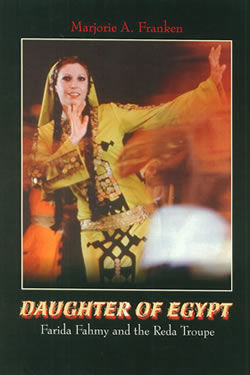Mahmoud Reda’s choreography introduced the Egyptians to a new concept in the use of space…He know the perspectives and dimensions of the stage. By making use of points of emphasis and juxtaposition in his choreography, he was able to enhance the different moods he wanted to evoke. (Fahmy 1987:28)
He was at his most innovative in adding ‘narrative dancing’ to Egyptian theatrical tradition: that is, he adapted old stories or themes which were danced. In these creations he had the freedom to invent new movements that harmonized with traditional Egyptian dancing. The ‘Arayis al–Mulid’ (Brides of the Festival) dance, is an excellent example. Here, the movement utilizes all levels and depths of a Western performance space. Also in line with traditional men practiced exercised specific to their dance movement and women did likewise. The purpose in these differences, was to preserve the traditional differences observed in the often segregated dancing of Egyptian women and men:
Exercises for women included hip and waist movements found in diverse (female) dance styles in Egypt. Warm-ups for men concentrated on the flexibility of the thighs and torso; their exercises included knee bends and execution of turns, as well as the specific movements and steps of indigenous dances. (Fahmy 1987: 25).
This foundation, using a continuity of involvement of specific body parts and moves, made the Reda choreographies recognisaby Egyptian to their local audiences.
Mahmoud’s goal was to create a new theatre danceform rather than transplant dances from their local settings onto the stage. His works were never direct imitations or accurate reconstructions. They were his own vision of the movement qualities of Egyptians. His choreographies remain to this day his personal interpretation of the essential ingredients of the posture, carriage, and gesture of his country’s men and women. (Fahmy 1987:24)
In the earliest dances, the familiar features of Old Cairo and nearby villages were peoples with equally familiar characters – the policeman, the licorice vendor and his customers, the village major and the peasant girls, for examples, were the stuff of childhood memories set to old, but well loved songs. The first performances of the Reda troupe were like ‘slices of life’; scenes about which the audience could feel nostalgic and comfortable. The scenes on the Mulid dance mentioned above, included the lanterns and sugar-doll confections peculiar to Cairo’s annual festival of one of the ‘saint’s days’. Other dances were based on folktales with characters added.
In 1965 Mahmoud began fieldwork to find material from various provinces. As a result, several dances were developed from local traditions, including Al-Dahhiyya from Sinai, Al Kaff (clapping dance) from Assuit, and a Nubian dance from Aswan. Although not every region in Egypt has a characteristic dance style.
There was a Sohag stick dance that is the core of what became a larger dance called al-‘Assaya, eventually including female dancers as well. Al-‘Assaya is based on a martial arts form from Upper Egypt that uses a four foot long stick.
In this dance, each dancer displays his own individuality and style in manipulation the stick. In Mahmoud’s version, the stylized manner of the participants was retained, as well as the movements and postures particular to this style of dancing. The stick is used throughout the dance, in movements portraying a confrontation with an imaginary contender. The attack movements include circular swaying and swings, as well as direct thrust of the stick at various angles . . . In parts of this dance, various hops, skips and jumps were introduced. Directions and levels were changed, with sudden turns or jumps. Movements slowed down or gathered momentum in response to the strongly accented tempo of the drums (Fahmy 1997:49 and 53).
The same meticulous care that went into the choreographies was applied to the costuming, which played an important role: costumes and colour were genuine, but modified where necessary for the purposes of production. Costumes, as well as footwear, headgear, hair, turbans, etc. had to be historically correct, but had to serve the movement of the dancers as well. Women’s costumes that were traditionally layered, had to be layered. In another example of costume authenticity, the turbans representing the Upper Egyptian style, were painstakingly wound each time dancers put them on their heads.
***
Copyright 2009 Farida Fahmy
Mahmoud Reda peacefully passed away 10th July 2020 in Cairo



